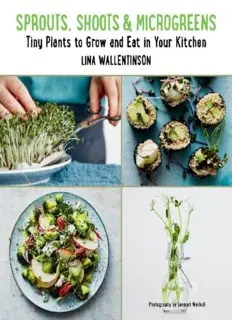
Sprouts, Shoots, and Microgreens: Tiny Plants to Grow and Eat in Your Kitchen PDF
Preview Sprouts, Shoots, and Microgreens: Tiny Plants to Grow and Eat in Your Kitchen
CONTENTS Growing for the Impatient INTRODUCTION Homegrown in a Flash From Miracle Food to Viable War Ration—A History of Sprouting From Seed to Sprout—What Happens to the Nutrients? SPROUTS Sprout Profiles Recipes—Sprouts SHOOTS & MICROGREENS Shoot Profiles Recipes—Shoots & Microgreens Index Acknowledgments Sources Conversion Charts GROWING FOR THE IMPATIENT t the grocery store, we’re typically drawn to the colorful displays of fresh A fruits and vegetables. Spicy radishes, shiny apples, and sunny lemons all brazenly clamor for our attention. Meanwhile, we easily miss the shelves where the dried lentils, beans, and peas can be found. Now and again we’ll grab a packet of red lentils for a quick soup, but what are those dried khaki mung beans and yellow peas good for? At first, that was my thought when, in my capacity as food writer, I was asked to come up with an article about beans and peas. This meant I would have to hang around those shelves a little longer. Somewhat half-heartedly, I picked up, prodded, and looked over the labels of the packets, their contents ranging in color from dull brown and yellow to mild green and muted orange. Gradually, as I learned more about legumes, it dawned on me that there was actually more life here than in the vegetable aisle, even though this life was dormant; hundreds of small seeds within these packets were just waiting to start sprouting. I began to grow sprouts and shoots as often as I could. Some shot up but tasted only okay, while others didn’t want to go along with my plan at all. However, most of them turned into tasty sprouts and crisp shoots with surprising ease. That bag of mung beans took on a whole new level of significance. These are the kings of all sprouts: they always produce a reliable harvest, and in four days or so become hearty bunches of crisp sprouts ready to be tossed into the nearest pad thai or other stir-fry. And dried peas—like ugly ducklings, these bashful soup peas grow into the city’s most elegant shoots within a short couple of weeks. And let’s not forget about lentils, which will grow into a tasty tangle after only two or three days. Once you notice there is indeed life on the store shelf stocked with dried legumes, you’ll discover more varieties. Take buckwheat, for example; while dry as dust, it only needs a bit of love and plenty of water to quickly soften into nice, triangular-shaped seeds with a timid little mini-sprout, at which point it’s ready to perk up any salad or enhance a smoothie. Sunflower seeds, too, react without much prompting: you can almost see the sprouts begin to grow the moment they connect to water. I’ve never really tended a garden, even though I have one. Everything happens so slowly. I’ve just never been interested in waiting several weeks— sometimes months—without any guarantee that things will come up. However, sprouts and shoots are quick and prolific, and become instant food! They’re an impatient grower’s dream!
